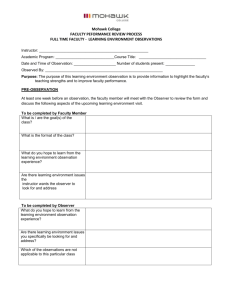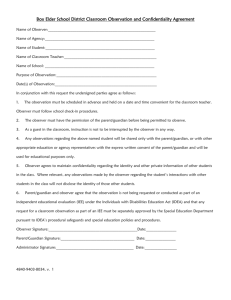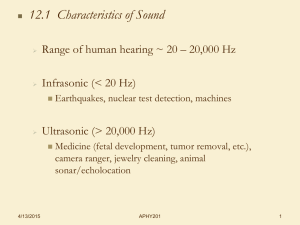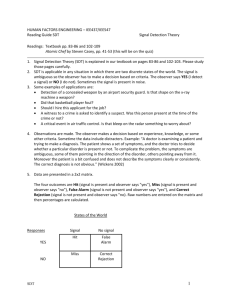Problem Set 1
advertisement
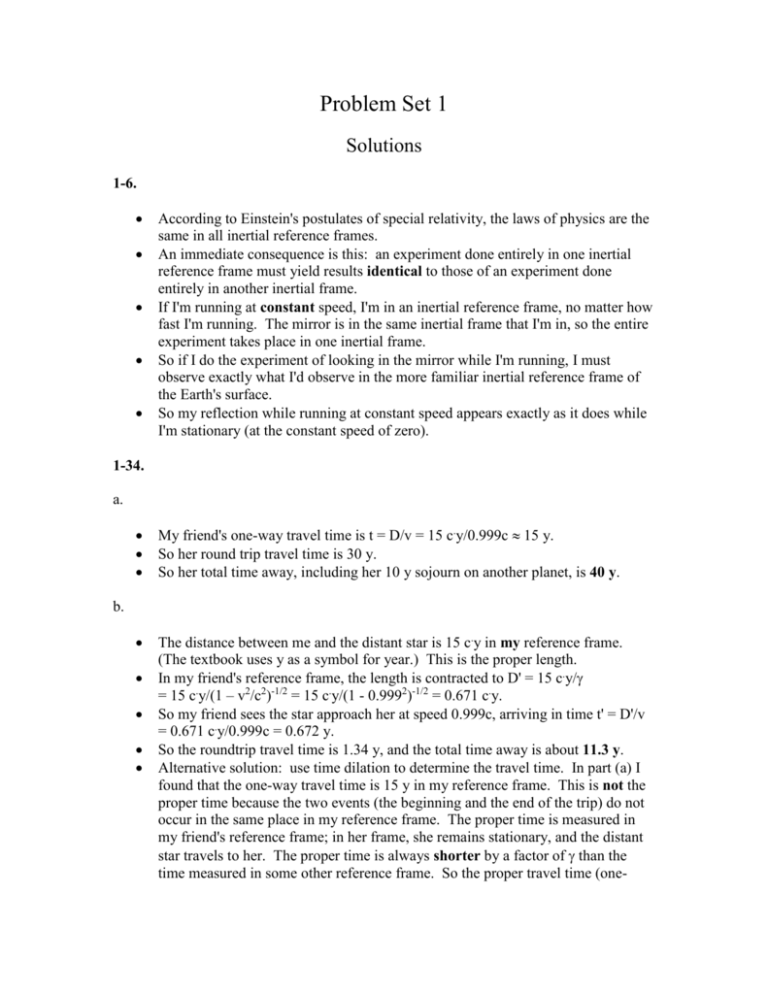
Problem Set 1 Solutions 1-6. According to Einstein's postulates of special relativity, the laws of physics are the same in all inertial reference frames. An immediate consequence is this: an experiment done entirely in one inertial reference frame must yield results identical to those of an experiment done entirely in another inertial frame. If I'm running at constant speed, I'm in an inertial reference frame, no matter how fast I'm running. The mirror is in the same inertial frame that I'm in, so the entire experiment takes place in one inertial frame. So if I do the experiment of looking in the mirror while I'm running, I must observe exactly what I'd observe in the more familiar inertial reference frame of the Earth's surface. So my reflection while running at constant speed appears exactly as it does while I'm stationary (at the constant speed of zero). 1-34. a. My friend's one-way travel time is t = D/v = 15 c.y/0.999c 15 y. So her round trip travel time is 30 y. So her total time away, including her 10 y sojourn on another planet, is 40 y. The distance between me and the distant star is 15 c.y in my reference frame. (The textbook uses y as a symbol for year.) This is the proper length. In my friend's reference frame, the length is contracted to D' = 15 c.y/ = 15 c.y/(1 – v2/c2)-1/2 = 15 c.y/(1 - 0.9992)-1/2 = 0.671 c.y. So my friend sees the star approach her at speed 0.999c, arriving in time t' = D'/v = 0.671 c.y/0.999c = 0.672 y. So the roundtrip travel time is 1.34 y, and the total time away is about 11.3 y. Alternative solution: use time dilation to determine the travel time. In part (a) I found that the one-way travel time is 15 y in my reference frame. This is not the proper time because the two events (the beginning and the end of the trip) do not occur in the same place in my reference frame. The proper time is measured in my friend's reference frame; in her frame, she remains stationary, and the distant star travels to her. The proper time is always shorter by a factor of than the time measured in some other reference frame. So the proper travel time (one- b. way) is 15 r/ = 0.671 y. (Rounding error makes this slightly different from the value found above.) 1-43. a. = (1 – v2/c2)-1/2 = (1 - 2)-1/2 = (1- 0.922)-1/2 = 2.55. b. The proper (life)time is always shorter by a factor of than the time measured in any other frame, so the mean lifetime measured in the laboratory frame is a factor of greater than the proper lifetime: 2.6 10-8 s = 6.63 10-8 s. c. In the lab frame, the mesons travel 50 m in a time t = D/v = 50 m/0.92c = 50 m/(0.92 3 108 m/s) = 1.81 10-7 s. The basic equation for radioactive decay is N = N0e-t/lifetime, where t/lifetime = 1.81 10-7/6.63 10-8 = 2.73. So N = 50,000e-2.73 3300. d. If we had mistakenly used the proper lifetime instead of the lifetime observed in the laboratory frame, we would have found t/lifetime = 1.81 10-7/ 2.6 10-8 = 6.96 and N = 50,000e-6.96 = 47. This is much different from the 3300 found above! Relativistic effects are significant in some physics experiments. 1-57. a. I must first determine how far the S frame sees the S' observer travel in the time it takes the S' clock to advance 60 min. The S' clock records proper time in the S' frame. Proper time is always shorter than time intervals measured in other frames. So when the S' clock shows 60 min, the S frame will find that 60 min has passed. In 60 min, the S frame sees the S' observer travel Da = vt = 0.6c 60 min: Da = vt = 0.6c 60 min t = 60 min t' = 60 min v x S observer S' observer At this instant (when the S' observer's clock shows 60 min), the S' observer sends a signal. The signal requires time Da/c = 0.6c 60 min/c = 0.6 60 min to reach the S observer. So the time when the signal reaches the S observer is the sum of two time intervals: the time it takes the S' clock to advance 60 min (as observed in the S frame) and the time it takes the signal from the S' observer to travel back to the S observer. This total time is 60 min + 0.6 60 min = 1.6 60min, where = (1 – 0.62)-1/2 = 1.25. The total time is then 1.6 1.25 60 min = 120 min. b. The S observer sends a signal at t1 = 60 min. At this moment, the S' observer is a distance Db1 = vt1 = 0.6c 60 min away: Db1 = vt1 = 0.6c 60 min t = 60 min v x S observer S' observer Since the S' observer is moving away from S at a speed of 0.6c and the signal chases the S' observer at a speed of c, the signal gains on the S' observer at a rate of 0.4c. The signal thus requires Db1/0.4c = 0.6c 60 min/0.4c = 90 min to reach the S' observer. Since the signal was sent at time 60 min, the signal reaches the S' observer at time t2 = 150 min. At this instant, the S' observer sends the confirmation signal. At 150 min, the S' observer is a distance Db2 = vt2 = 0.6c 150 min away: Db2 = vt2 = 0.6c 150 min t = 150 min v x S observer S' observer It takes the confirmation signal Db2/c = 0.6 150 min = 90 min to travel back to the S observer. Since the confirmation signal was sent at time 150 min, the confirmation signal reaches the S observer at time 240 min. There's a simpler solution! If we swapped our labels (S becomes S', S' becomes S), the solution to part (a) wouldn't change; therefore, since S receives the first signal when the S clock shows 120 min (as found in part a), S' must receive the first signal when the S' clock shows 120 min. So S' sends the confirmation signal when the S' clock shows 120 min. We already know from part (a) what happens when S' sends a signal at time on the S' clock: S receives it at time 2 on the S clock. c. First signal sent: First signal received: Confirmation signal received: 60 min (as stated in the problem) 120 min (as found in part a) 240 min (as found in part b) The situation is identical in the two inertial reference frames; each reference frame sees one observer staying still and one observer moving at speed 0.6c. So the S' observer would construct exactly the same table as the S observer.



